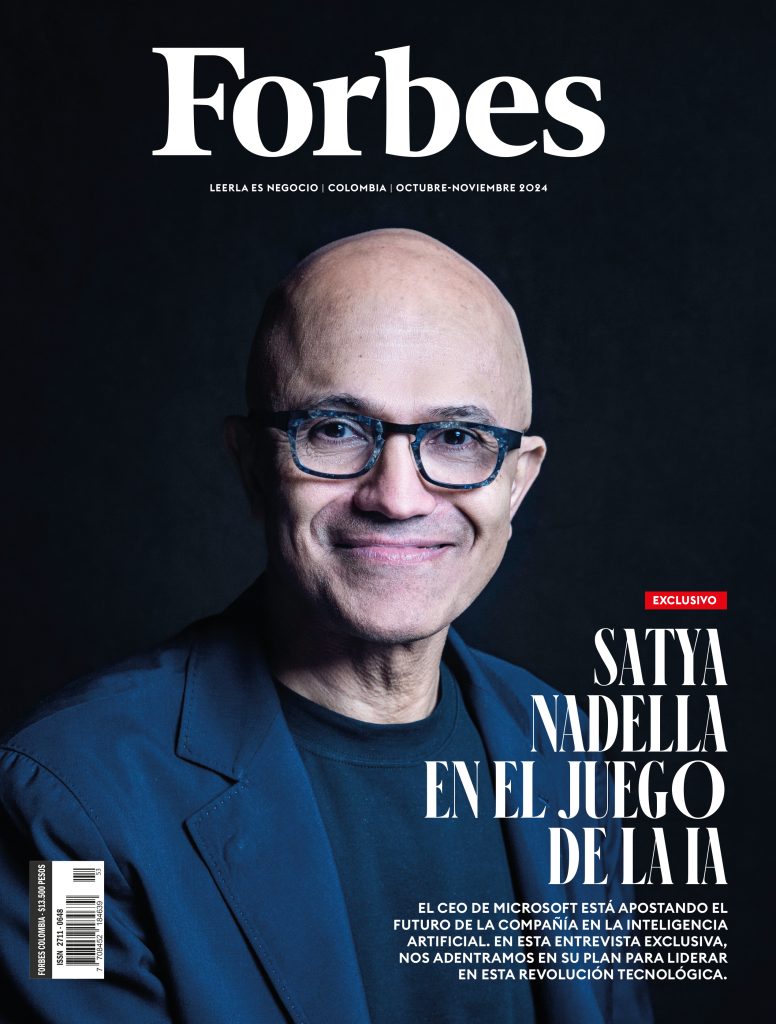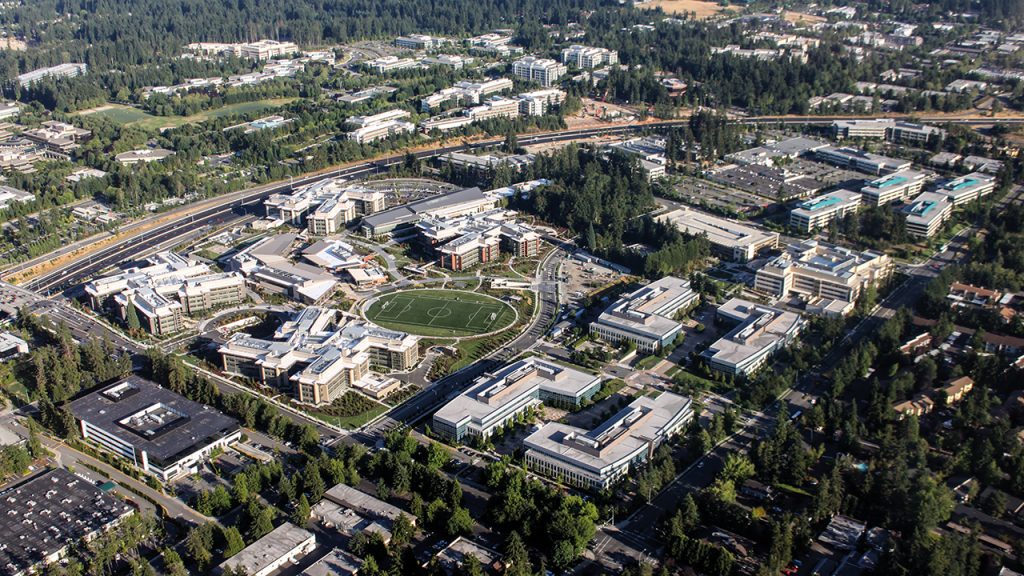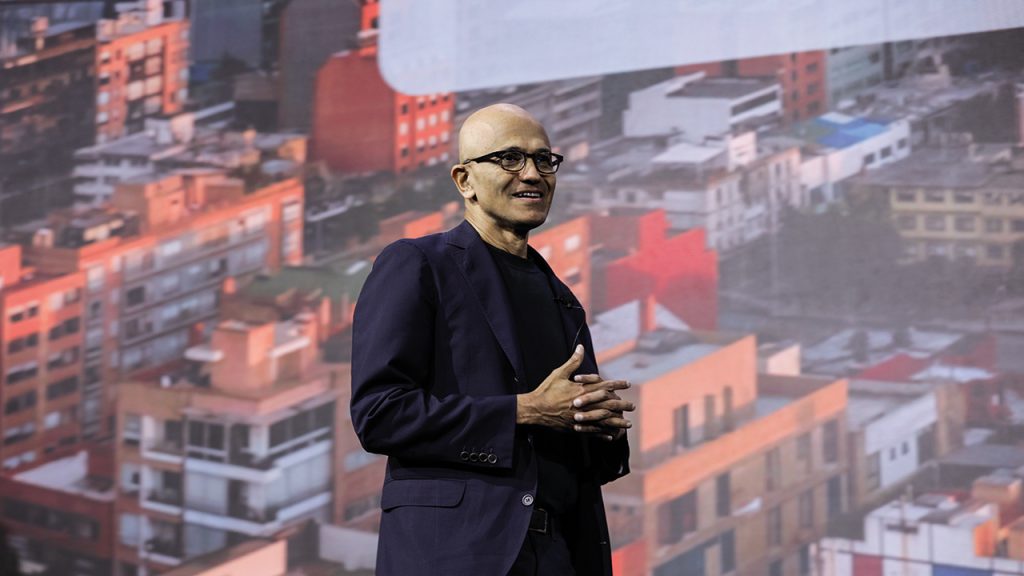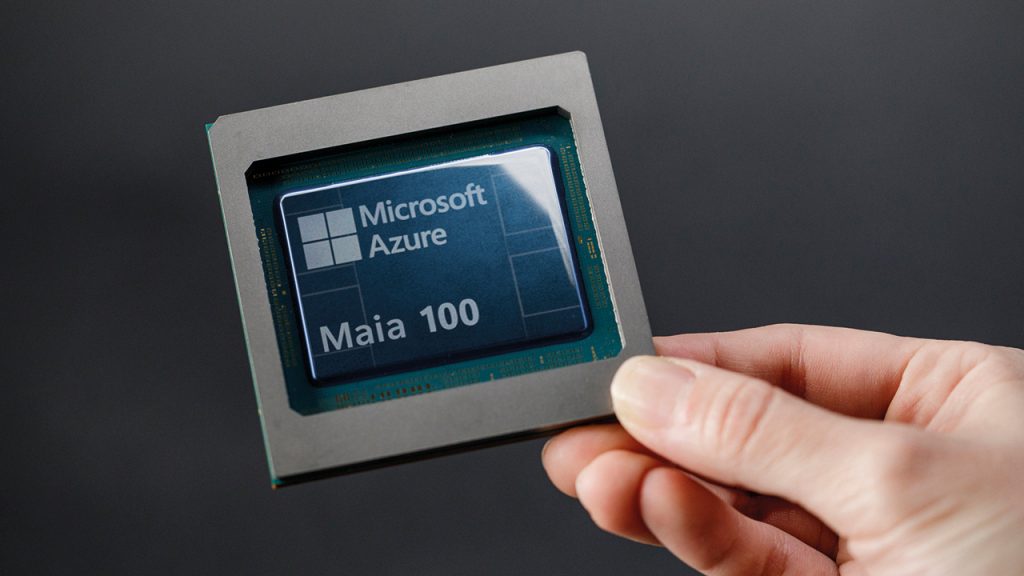Microsoft’s CEO, Satya Nadella, is betting the company’s future on artificial intelligence. In this exclusive interview, we delve into his multi-billion-dollar strategy to lead this technological revolution.
When ChatGPT, a tool capable of understanding text and generating human-like conversations, captured the world’s attention in November 2022, all eyes were on OpenAI, an artificial intelligence research startup that had developed it.
What was little mentioned at the time was that Satya Nadella, Microsoft’s CEO, had access to that tool months earlier because, in 2019, he took a risk: investing $1 billion in OpenAI, which had started as a non-profit research lab, in a partnership that in the following years would lead to an additional $13 billion investment.
Microsoft leveraged OpenAI’s technology to launch GitHub Copilot, a tool used by software developers to automate code writing. The product attracted over one million developers in just a year. Since then, Satya Nadella’s enthusiasm for taking a leadership position in the AI race has materialized through multi-billion-dollar investments betting on this technology.
“We’ve been working on AI for many years. In fact, some of the early ResNet—a deep learning model—was done in Microsoft,” Nadella tells Forbes in an exclusive interview during a series of conferences he held throughout Latin America. “When I started to see that you could take natural language and apply scaling laws to it is when I think our conviction grew. And of course, when we started to see products like GitHub co-pilot that we could build, that’s when we doubled down. And so it’s exciting to be here in 2024 leading this wave.”
What Satya, now 57, has demonstrated since taking the CEO role a decade ago is that he was the ideal successor to his predecessor Steve Ballmer and a worthy heir to the legendary Bill Gates. As an engineer who came from India to the United States as a student, he rose through the ranks at Microsoft to become the leader credited with restoring the company’s shine.

Since his arrival, he reversed the ill-fated $8 billion acquisition of Nokia’s phone division, positioned Microsoft’s software on Apple’s iPads and iPhones, embraced the concept of open-source software, and turned Azure, Microsoft’s cloud computing business, into a powerhouse.
“Leadership is such a privilege that it ultimately comes down to leaders having the ability to first, in uncertain times, in fast-changing times, in ambiguous times, to bring clarity,” Nadella explains. “Leaders also create energy. It’s not just about one team. It’s about, you know, the entirety of the folks who need to come together to achieve something big inside the company, outside the company. You generate energy. And lastly, you know, leaders also have the ability to create solutions even in over-constrained situations by figuring out what to unconstraint.”
Today, with its ecosystem of productivity, computing, cloud, applications, and gaming, this company is committed to empowering people and organizations around the world to achieve more.
They have successfully integrated acquisitions made under Nadella’s leadership, such as GitHub, the collaboration platform for developers acquired for $7.5 billion; LinkedIn, the professional social network for $26.2 billion; Minecraft, the popular video game bought for $2.5 billion; and, more recently, Activision Blizzard, in a $69 billion transaction.
Now, Microsoft’s 228,000 employees around the world have a clear direction: to stay ahead in the race for artificial intelligence, where tech giants like Google, Amazon, and Meta are also making their own bets.
At its headquarters in Redmond, Washington, there’s a campus where, amidst the offices, secret labs are hidden. Here, they’re developing everything from proprietary chips to optimize AI infrastructure to computers with features like helping find anything viewed on the PC or canceling background noise in a video call.

Almost everything is powered by Microsoft Copilot, an artificial intelligence agent that automates functions in applications like Word, Excel, PowerPoint, Outlook, and Teams, and also works with the Bing search engine and the Windows operating system.
Satya says that one of the first things he does when he wakes up at 5:30 a.m. is review AI-generated tags that analyze the content of messages and the context of his work to sort important emails. During the day, he checks the summaries of meetings through the Teams video conferencing platform.
“Everybody complains about meetings, but the real thing that should be complained about is nobody prepares for meetings, nobody pays attention to meetings, nobody remembers what happened. But now, meetings are an entry into the enterprise knowledge base. I can go back and reference, how did that desired decision get made? And you can absolutely get it back in real-time,” Nadella explains. “I always describe it as I think with AI, work with humans.”
Recently, they launched Pages, which allows companies to search both the web and internal databases to generate new documents that can be collaboratively edited with others.
Microsoft’s investors seem to love this approach. Over the past two years, the billions that Nadella has allocated to artificial intelligence have driven the company’s valuation to exceed $3 trillion, a 70% increase. With each passing day, Microsoft competes head-to-head with Apple and chipmaker Nvidia for the title of the world’s most valuable company.
“I think that one of the fundament fundamental challenges is going to be about us rethinking process and workflow, right? Because ultimately we are accustomed to doing work with one way. AI now helps us reimagine that work, workflow, and work artifact. Just like back in the day, remember, pre-PC, I even started to think, how did we do something like a forecast. Faxes went around, and inter-office memos got written, and what have you, and then suddenly you sent an Excel spreadsheet, an email, and a forecast got done. So that process reimagination with new tools, like Copilot, I think is what’s going to be the driver of productivity. And by the way, you see this in most conclusive evidence already in software development, right? In software development, GitHub Copilot went from being non-existent to becoming a standard issue for every software development team within maybe a period of a year. And now, software projects are completely going to be transformed because of that.”
Microsoft’s stock has appreciated by more than 200% over the past five years.

To secure a leading position in this race, Nadella spends his days observing the emerging AI startups and attracting talent. In addition to OpenAI, Microsoft has invested in more than 20 AI startups, including a $16 million partnership with the French startup Mistral AI.
Earlier this year, Satya Nadella made a decision that surprised both Silicon Valley and Wall Street: he struck a deal to bring Mustafa Suleyman, co-founder of DeepMind —acquired by Google— and Inflection AI, into Microsoft’s ranks.
To make this happen, Nadella closed a $650 million technology licensing deal, hired most of Inflection AI’s team, and put Suleyman in charge of a new AI division with investments exceeding $12 billion.
With this deal, Microsoft did not acquire any equity or intellectual property from Inflection AI, a structure that didn’t trigger the requirement to report to antitrust authorities.
Suleyman, now heading Microsoft’s consumer AI group, has been tasked with transforming the way people interact with technology by creating AI “agents” that could radically change personal computing. He now oversees more than 10,000 employees and controls Microsoft’s main consumer products, including Bing.
For regulators, these moves in the AI race are causing enough stir to increase scrutiny on Microsoft in the AI field. The U.S. Federal Trade Commission has made inquiries into the company’s investment in OpenAI and its deal with Inflection AI. Regulators are questioning whether this maneuver was a calculated move to gain control of a rival AI company without triggering oversight from the authorities.
“We had lots of AI talent before we partnered with OpenAI and we now have a lot of AI talent internally at Microsoft, including folks like Mustafa who came from inflection and others who have been building models like Phi inside the company,” Nadella states. “We continue to partner with OpenAI. We continue to build on top of their model. PHY, for example, is essentially a model that uses OpenAI to build SLMs. We love that. We are also going to build whatever is needed in order to build great products. Ultimately, I think great infrastructure and great products is where a lot of the value in this AI generation gets created and that’s what we plan to do.”

Nadella has embarked on a global AI tour to discuss how artificial intelligence is changing people’s lives and jobs. In Mexico, he announced a $1.3 billion investment, and in Brazil, a $3 billion investment to enhance cloud and AI infrastructure.
In Colombia, he was impressed by Guacamaya, a project that uses satellite images and camera traps with AI models to identify deforestation patterns, as well as by a judge who uses AI in virtual judicial hearings to generate transcripts, summarize proceedings, and assist in creating minutes.
“I met with Bancolombia. They have 2,000 software developers already using GitHub Copilot. In fact, they have big ambitions to take it to the next level and create their own agent. I also met with an appliance company—Haceb—that has developed an agent called Wilson for its field service,” Nadella points out. “All these initiatives are highly ambitious. I also visited Sura, which is striving to better represent Latin America in medical records to offer personalized medicine that takes into account genomic, medical imaging, and clinical data from the region. These are outstanding examples of ambitious work being carried out in real-time as these new models emerge.”
Such advancements are being seen throughout Latin America. In Argentina, YPF has optimized contract management using GAIA, a generative AI solution that improves operational efficiency. In Chile, Colbún has transformed its operations with Microsoft 365 Copilot, freeing up employees for strategic tasks. In Peru, Yape has facilitated digital payments for 12 million users, while Credicorp has launched an AI chatbot on WhatsApp to advise on climate emergencies, promoting community preparedness.

Recently, Apple integrated OpenAI’s AI features into its operating system, in a partnership that Microsoft doesn’t seem to mind.
“We are very thrilled to be partnered with OpenAI. Effectively, we were the first ones to sponsor them. They were really more of a research institution, and the progress they’ve made is stunning. I think Sam and team have been extraordinary in their ability to pick right when it comes to research. They’re generating even unbelievable products and what have you, like ChatGPT,” says Nadella. “We are thrilled to be partnered. We are excited to see even O1 release as part of Azure AI, and we’re using it everywhere. In fact, I just showed even how it’s been integrated to GitHub. And we’re thrilled about Apple and, you know, their partnership with Apple, because ultimately for us, OpenAI runs on our cloud in Azure, and more customers OpenAI has. It’s a great way for us to continue to partner with OpenAI and drive their success and their partnerships.”
While the world marvels at the power of generative AI to create text and images, a bigger question arises: what’s next?
The promise of Artificial General Intelligence—a system capable of understanding, learning, and applying knowledge across a wide variety of tasks at a human-like or superior level—remains just that: a promise, still far from becoming a reality.
“It’s important to ensure there is trust around AI,” Nadella emphasizes. “We are very excited about this broad initiative around responsible AI and the security and privacy commitments we’ve made. It’s not just about the commitments, but about continuously improving our capabilities to align with them.”
And the Microsoft CEO concludes: “The new AI safety correction features in Azure AI are designed to increase trust, because, after all, AI models have hallucinations. How can we use AI to fix AI? That’s a new mechanism we’re excited to apply to all models. So, this combination of commitments and capabilities that we’re continuing to build within a framework of responsible AI is what we aim to achieve.”

